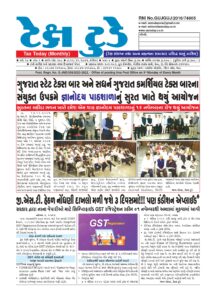Agriculture land and Income Tax… Confusing yet clear….

Agriculture land and Income Tax… Confusing yet clear….
Friends, In my view, Capital Gain has more debatable issues than any other source of income under the Income Tax. Today in this article I have tried to take one such issue under the capital gain. The issue is taxability of Agriculture Land.
Broadly, For Income Tax purpose, there are two categories in which the agriculture land can be divided in to following two parts.
- Urban Agriculture Land: Urban Agriculture Land is a capital assets under the Income Tax Act and is taxable like other assets.
- Rural Agriculture Land: Rural agriculture land is not considered as a capital assets under the Income Tax Act, 1961 and is not taxable under the Income Tax Act, 1961.
The first and foremost thing to understand is the definition U/s 2(14) of the Income Tax Act, 1961. There has been a major amendment in the definition of Capital assets w.e.f. 01.04.2013. Let’s study both the definitions in detail.
From A Y 2014 15, i.e. taxability w.e.f. 01.04.2013:
The extract of section 2(14) is produced below:
(14) “capital asset” means—
(a) property of any kind held by an assessee, whether or not connected with his business or profession;
(b) any securities held by a Foreign Institutional Investor which has invested in such securities in accordance with the regulations made under the Securities and Exchange Board of India Act, 1992 (15 of 1992),
but does not include—
(i) any stock-in-trade [other than the securities referred to in sub-clause (b)], consumable stores or raw materials held for the purposes of his business or profession ;
(ii) personal effects, that is to say, movable property (including wearing apparel and furniture) held for personal use by the assessee or any member of his family dependent on him, but excludes—
(a) jewellery;
(b) archaeological collections;
(c) drawings;
(d) paintings;
(e) sculptures; or
(f) any work of art.
Explanation 1.—For the purposes of this sub-clause, “jewellery” includes—
(a) ornaments made of gold, silver, platinum or any other precious metal or any alloy containing one or more of such precious metals, whether or not containing any precious or semi-precious stone, and whether or not worked or sewn into any wearing apparel;
(b) precious or semi-precious stones, whether or not set in any furniture, utensil or other article or worked or sewn into any wearing apparel.
Explanation 2.—For the purposes of this clause—
(a) the expression “Foreign Institutional Investor” shall have the meaning assigned to it in clause (a) of the Explanation to section 115AD;
(b) the expression “securities” shall have the meaning assigned to it in clause (h) of section 2 of the Securities Contracts (Regulation) Act, 1956 (42 of 1956);
(iii) agricultural land in India, not being land situate—
(a) in any area which is comprised within the jurisdiction of a municipality (whether known as a municipality, municipal corporation, notified area committee, town area committee, town committee, or by any other name) or a cantonment board and which has a population of not less than ten thousand ; or
(b) in any area within the distance, measured aerially,—
(I) not being more than two kilometres, from the local limits of any municipality or cantonment board referred to in item (a) and which has a population of more than ten thousand but not exceeding one lakh; or
(II) not being more than six kilometres, from the local limits of any municipality or cantonment board referred to in item (a) and which has a population of more than one lakh but not exceeding ten lakh; or
(III) not being more than eight kilometres, from the local limits of any municipality or cantonment board referred to in item (a) and which has a population of more than ten lakh.
Explanation.—For the purposes of this sub-clause, “population” means the population according to the last preceding census of which the relevant figures have been published before the first day of the previous year;
(iv) 6½ per cent Gold Bonds, 1977, or 7 per cent Gold Bonds, 1980, or National Defence Gold Bonds, 1980, issued by the Central Government;
(v) Special Bearer Bonds, 1991, issued by the Central Government ;
(vi) Gold Deposit Bonds issued under the Gold Deposit Scheme, 1999 or deposit certificates issued under the Gold Monetisation Scheme, 2015 notified by the Central Government.
Explanation.—For the removal of doubts, it is hereby clarified that “property” includes and shall be deemed to have always included any rights in or in relation to an Indian company, including rights of management or control or any other rights whatsoever;
From the above definition, it is clear that to be a rural agriculture land, a land has to qualify both the below mentioned conditions.
- The land should be Out of the Municipality or Nagar Palika.
- The land should be aerially out of:
- 2 Kms in case of nearest Municipality or Nagar Palika having population of more than 10000 but not exceeding 100000/-
- 6 Kms in case of nearest Municipality or Nagar Palika having population of more than 1,00,000 but not exceeding 10,00,000/-
- 8 Kms in case of nearest Municipality or Nagar Palika having population of more than10,00,000/-
The most important change done w.e.f. 01.04.2013 is that the distance is now to be measured aerially. Prior to the amendment the road distance was to be taken. As a result of this Arial measurement, much more land may be part of urban agriculture land.
In other words, Any Agriculture land which is within the:
- In the municipal limits or within the limits of Nagar Palika is an urban agriculture land and is taxable.
- Within such two, six or eight Kilometres of the Municipal or Nagar Palika area is an Urban Agriculture land and is taxable.
Upto A Y 2013 14, i.e. up to 31.03.2013:
The extract of section 2(14) is produced below:
(14) “capital asset” means property42 of any kind held by an assessee, whether or not connected with his business or profession, but does not include—
(i) any stock-in-trade, consumable stores or raw materials held for the purposes of his business or profession ;
43[(ii) personal effects44, that is to say, movable property (including wearing apparel and furniture) held for personal use44 by the assessee or any member of his family dependent on him, but excludes—
(a) jewellery;
(b) archaeological collections;
(c) drawings;
(d) paintings;
(e) sculptures; or
(f) any work of art.
Explanation.—For the purposes of this sub-clause, “jewellery” includes—
(a) ornaments made of gold, silver, platinum or any other precious metal or any alloy containing one or more of such precious metals, whether or not containing any precious or semi-precious stone, and whether or not worked or sewn into any wearing apparel;
(b) precious or semi-precious stones, whether or not set in any furniture, utensil or other article or worked or sewn into any wearing apparel;]
45[(iii) agricultural land46 in India, not being land situate—
(a) in any area which is comprised within the jurisdiction of a municipality46 (whether known as a municipality, municipal corporation, notified area committee, town area committee, town committee, or by any other name) or a cantonment board and which has a population46 of not less than ten thousand according to the last preceding census of which the relevant figures have been published before the first day of the previous year ; or
(b) in any area within such distance, not being more than eight kilometres, from the local limits of any municipality or cantonment board referred to in item (a), as the Central Government may, having regard to the extent of, and scope for, urbanisation of that area and other relevant considerations, specify in this behalf by notification in the Official Gazette47;]
48[(iv) 6½ per cent Gold Bonds, 1977,49[or 7 per cent Gold Bonds, 1980,] 50[or National Defence Gold Bonds, 1980,] issued by the Central Government ;]
51[(v) Special Bearer Bonds, 1991, issued by the Central Government ;]
52[(vi) Gold Deposit Bonds issued under the Gold Deposit Scheme, 1999 notified by the Central Government.]
52a[Explanation.—For the removal of doubts, it is hereby clarified that “property” includes and shall be deemed to have always included any rights in or in relation to an Indian company, including rights of management or control or any other rights whatsoever;]
From the above definition, it is clear that to be a rural agriculture land, a land has to qualify both the below mentioned conditions.
- The land should be Out of the Municipality or Nagar Palika.
- The land should be in area which is notified by the Central Government.
In other words, Any Agriculture land which is within the:
- In the municipal limits or within the limits of Nagar Palika is an urban agriculture land and is taxable in every cases.
- If the agriculture land is outside the Municipal Area or Nagar Palika limits, then one has to answer the following question:
- Is the land situated in the area which is covered under the notification issued U/s 2(14)? [Notification No. [SO 9447] (File No. 164/3/87-ITA.I)], dated. 6-1-1994]
If the answer to the above question is Yes, one need to see the notification and also see the area specified in the notification. If the agriculture land is covered under such area it shall be an urban agriculture land and will become taxable. If the land is outside the area specified in the said notification, the land shall be rural agriculture land and shall not be taxable. Here, the land distance is to be considered as road distance. The amendment to consider Arial distance has been made effective from 01.04.2013.
It has been often seen that the Assessing officer considers the limits of 8 KMs from the Municipal Limits or Nagar Palika Limits for every land. The most important thing to understand here is that the 8 Km limit is an upper limit given to the Central Government for issuing notification U/s 2(14). In No cases, however developed the Municipal Area or Nagar Palika limits are, the 8 KM upper limit can’t be breached. For issuing the notification Central Government has to consider the urbanisation of the particular Municipality or Nagar Palika.
If The area in which land is situated is not covered under Notification, than can it be assumed that the limit has to be considered at 8 Kms?
No. The clear answer to this question is No. If the land is in area which is not covered under notification, than the land even 1 Meter outside the Municipal Area or Nagar Palika limit is an Rural Agriculture Land not taxable.
The Most Important utility provided by Income Tax Department to check whether the particular land is a Rural Agriculture Land or Urban Agriculture Land is provided on the portal www.incometaxindia.gov.in. It is a very important utility, but has assumed less usage as Tax Practitioners and assesses are not much aware about this utility. Following is the link to assess the utility:
https://www.incometaxindia.gov.in/Pages/utilities/Capital-Assets.aspx
(The utility is available in two parts: Up to A Y 2013-14 and From A Y 2014-15)
(Although every care has been taken in writing this article, one needs to read and understand the act and rules before taking any decision. Writer shall be no ways responsible for any act, deed etc done depending on the article. Always consult your tax consultant before taking any decision regarding taxation.)






